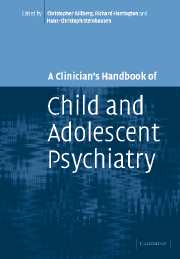Book contents
- Frontmatter
- Contents
- Preface
- List of contributors
- 1 Brain disorders
- 2 Substance use disorders
- 3 Schizophrenia and schizophrenia-like disorders
- 4 Affective disorders
- 5 Anxiety disorders
- 6 Obsessive-compulsive disorders
- 7 Adjustment disorders
- 8 Post-traumatic stress disorder
- 9 Functional somatic symptoms and somatoform disorders in children
- 10 Eating disorders: anorexia nervosa and bulimia nervosa
- 11 Sleep disorders
- 12 Personality disorders
- 13 Mental retardation/learning disability
- 14 Specific developmental disorders of speech and language
- 15 Reading and other learning disorders
- 16 Autism spectrum disorders
- 17 Hyperkinetic disorders
- 18 Conduct disorders
- 19 Elective mutism
- 20 Attachment and disorders of attachment
- 21 Tic disorders
- 22 Elimination disorders: enuresis and encopresis
- 23 Physical and sexual abuse
- 24 Gender identity disorders
- Index
- References
4 - Affective disorders
Published online by Cambridge University Press: 06 August 2009
- Frontmatter
- Contents
- Preface
- List of contributors
- 1 Brain disorders
- 2 Substance use disorders
- 3 Schizophrenia and schizophrenia-like disorders
- 4 Affective disorders
- 5 Anxiety disorders
- 6 Obsessive-compulsive disorders
- 7 Adjustment disorders
- 8 Post-traumatic stress disorder
- 9 Functional somatic symptoms and somatoform disorders in children
- 10 Eating disorders: anorexia nervosa and bulimia nervosa
- 11 Sleep disorders
- 12 Personality disorders
- 13 Mental retardation/learning disability
- 14 Specific developmental disorders of speech and language
- 15 Reading and other learning disorders
- 16 Autism spectrum disorders
- 17 Hyperkinetic disorders
- 18 Conduct disorders
- 19 Elective mutism
- 20 Attachment and disorders of attachment
- 21 Tic disorders
- 22 Elimination disorders: enuresis and encopresis
- 23 Physical and sexual abuse
- 24 Gender identity disorders
- Index
- References
Summary
The defining characteristic of affective disorders is a change in affect or mood. In both the Tenth Revision of the International Classification of Diseases (ICD-10) and in the Fourth Edition of the Diagnostic and Statistical Manual (DSM-IV) there are many different categories of affective disorder. For example, as Table 4.1 shows, ICD-10 contains seven main categories of mood disorder, each with several sub-categories. Depressive conditions can also be classified in other parts of ICD-10, particularly under adjustment disorders, which include Brief Depressive Reactions (F43.20), Prolonged Depressive Reactions (F43.21) and Mixed Anxiety and Depressive Reactions (F43.22).
In clinical practice the most useful distinction is between disorders characterized by depression of mood (e.g. depressive episode, recurrent depressive disorder) and disorders in which there is a distinct period of elevated mood (e.g. manic episode, bipolar disorder). The present chapter is therefore divided into two sections, the first concerned with depressive disorders and the second with bipolar disorders (by convention, all patients with mania are classified in the bipolar group, whether or not they have had depression) (see Fig. 4.1).
Depressive disorder
Introduction
Until recently it was widely believed that depressive disorders were rare in young people. Young children were thought to be incapable of experiencing many of the phenomena that are characteristic of depressive disorders in adults. Affective disturbance in adolescents was often dismissed as adolescent ‘turmoil’. Over the past 20 years, however, there has been a substantial change in the ways in which mood disturbance among the young has been conceptualized.
- Type
- Chapter
- Information
- A Clinician's Handbook of Child and Adolescent Psychiatry , pp. 110 - 143Publisher: Cambridge University PressPrint publication year: 2006
References
- 2
- Cited by



